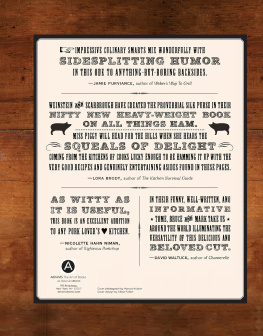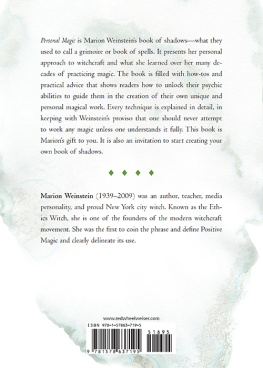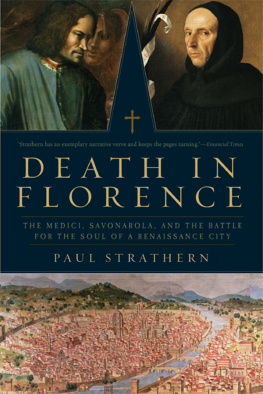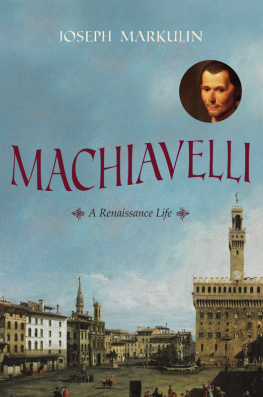SAVONAROLA

SAVONAROLA
The Rise and Fall
of a Renaissance Prophet

DONALD WEINSTEIN

Copyright 2011 by Donald Weinstein.
All rights reserved.
This book may not be reproduced, in whole or in part, including illustrations, in any form (beyond that copying permitted by Sections 107 and 108 of the U.S. Copyright Law and except by reviewers for the public press), without written permission from the publishers.
Yale University Press books may be purchased in quantity for educational, business, or promotional use. For information, please e-mail U.K. office).
Set in Adobe Caslon type by Keystone Typesetting, Inc., Orwigsburg, Pennsylvania.
Printed in the United States of America.
Library of Congress Cataloging-in-Publication Data
Weinstein, Donald, 1926
Savonarola : the rise and fall of a Renaissance prophet / Donald Weinstein.
p. cm.
Includes bibliographical references and index.
ISBN 978-0-300-11193-4 (cloth : alk. paper) 1. Savonarola, Girolamo, 14521498. 2. DominicansItalyFlorenceBiography. 3. ReformersItalyFlorenceBiography. 4. Florence (Italy)Biography. 5. Florence (Italy)Politics and government14211737. 6. Florence (Italy)Church history. 7. Catholic ChurchItalyFlorenceHistory. I. Title.
DG737.97.W43 2011
282.092dc23
[B]
2011032980
Catalogue records for this book are available from the Library of Congress and the British Library.
This paper meets the requirements of ANSI/NISO Z39.48-1992 (Permanence of Paper).
10 9 8 7 6 5 4 3 2 1
To Giles Constable
Contents
Illustrations follow page
Acknowledgments
My greatest debt is to my wife, Beverly Parker. Her moral support, editorial acumen, technical skills, and intelligence have been with me all the way. I could not have written this book without her. Four friends have been extraordinarily helpful. Lorenzo Polizzotto placed his unmatched knowledge of Savonarola and his movement at my disposal and has been a precise, constructive, and sympathetic reader and critic; Alan E. Bernstein has taught me much about medieval religion over the years, and I have benefited greatly from his suggestions, counsel, and friendship; Stefano DallAglio has been unfailingly generous in responding to my countless calls for help with archival and bibliographical problems, caught a number of slips, and readily shared his expertise on sixteenth-century Savonarolism; Jim Banker, my old companion in the Florentine archives, has read the book with his sharp eye for detail and sense of style.
Other friends and fellow scholars who have provided critical assistance are JoAnne Bernstein, Alison Brown, Gene Brucker, Cornelia Carlson, Mel Carlson, Giles Constable, Gail Eifrig, Christopher Fulton, Richard Gold-thwaite, Sarah Blake Hamm, Valerie Hotchkiss, Howard Kaminsky, Kate Lowe, Lauro Martines, Julia OFaolain, Olga Zorzi Pugliese, David Price, Fr. Fausto Sbaffoni, O.P., Piero Scapecchi, Herbert Schneidau, Ludovica Sebregondi, Fr. Armando F. Verde, O.P., Mark Zucker.
Warm thanks to the editors at Yale University Press who have enthusiastically and skillfully guided the book through the stages of publication, especially to Eliza Childs, copy-editor senza pari, with whom collaboration has been a pleasure. The manuscript she returned is far more presentable than the one she received. Even so, senior editor Margaret Otzel found still more room for improvement. A special thanks to the skilled, dedicated members of the Interlibrary Loan staff at the University of Arizona Library. Their cheerful cooperation and efficiency in tracking down remote scholarly items has been indispensable.
A Note on Usages
Time
The year. In fifteenth- and sixteenth-century Florence the new year began on March 25, the Feast of the Annunciation. Since this may cause some confusion to the reader, I have adjusted dates from January 1 through March 24 to conform to the current system.
The day. In Savonarolas time the hours were counted from sunset in a twenty-four-hour sequence. The first hour was an hour after sunset, the second two hours after sunset, and so on. In converting to the modern system I have taken into account the seasonal changes of sunset, but times are only approximate. Thus the hour of Savonarolas execution is given as 13, approximately 8 a.m.
Money, Weight, Measures
Money. The fiorino, or scudo, contained about thirty-two grams of gold and equaled seven lire. The lira contained twenty soldi, each equivalent to twelve denari. Three, later four, denari made up a quattrino. (The average wage of an unskilled worker was eight to ten soldi per day. Skilled construction workers were paid about twothree times as much.) (On wages I follow Richard A. Goldthwaite, The Building of Renaissance Florence: An Economic and Social History [Baltimore, 1980] app. 3, Workers Wages.)
Dry measure. The staio was equivalent to about three-quarters of a modern bushel.
Linear measure. The braccio (plural braccia) equaled about two feet.
Bible Citations
I have supplied key biblical references where I can identify them. Because the numbering system for Psalms 10 to 147 differs between Catholic and Protestant versions, I have supplied the numbers used by each. Thus Psalm 10 in the Vulgate is Psalm 11 in the Revised Standard Version, and I write it as (Ps. 10/11).
Also note differences in numbering of the books of Samuel and Kings:

Except when noted or when quoting from a published translation, the translations are my own.
Prologue
On the morning of May 23, 1498, Girolamo Savonarola and two fellow Dominican friars, Domenico da Pescia and Silvestro Maruffi, were hanged and burned in the main square of Florence, the city they had hailed as the New Jerusalem (see Fig. 1). Relentless interrogation and bone-breaking torture had wrung incriminating admissions from each of them, most devastatingly from Savonarola, the triumvirates leader. In a written statement read by an official to a perplexed and uneasy public, fra Girolamo declared that his prophecies of Florentine glory and Christian renewal were bogus, inspired not by God but by his own ambition for worldly glory and political power.
One of his admirers, the apothecary Luca Landucci, heard the confession and recorded his feelings in his diary. I was there to hear the statement and I remained dumbfounded and bewildered. I was grief stricken to see such a grand edifice come crashing to earth because it had been built so wretchedly on a single lie. I was expecting Florence to become a new Jerusalem out of which would come the laws and splendor and example of the good life, and to see the renovation of the Church, the conversion of the infidels, and the consolation of the righteous. Instead, I realized, everything was just the opposite. So I had to swallow the medicine: All things, O Lord, are in thy will [Eph. 1.11?].
Many who came to witness the execution, Landucci reported, hoped for a sign that would prove the truth of Savonarolas glorious prophecies. But no sign was forthcoming; he went to his death without a word and their remaining faith was shattered. Still, a few good people had so much faith that they braved official displeasure by secretly gathering the ashes that had been ordered thrown into the Arno.
Next page












